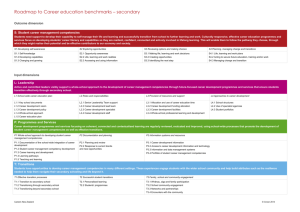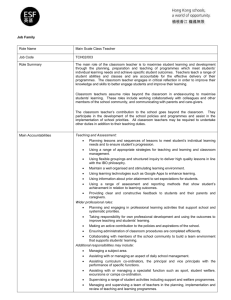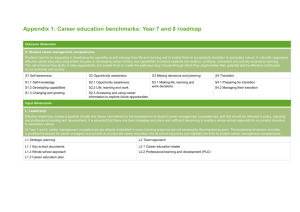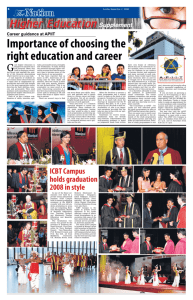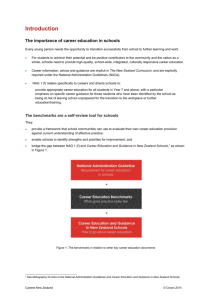the start point check sheet
advertisement
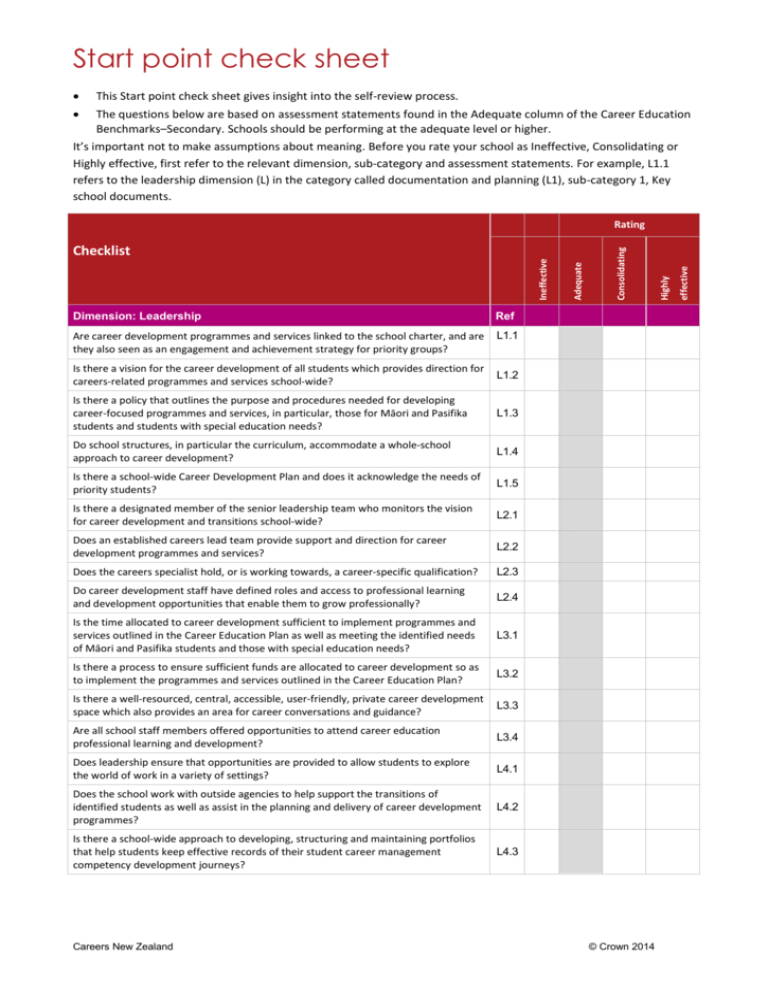
Start point check sheet This Start point check sheet gives insight into the self-review process. The questions below are based on assessment statements found in the Adequate column of the Career Education Benchmarks–Secondary. Schools should be performing at the adequate level or higher. It’s important not to make assumptions about meaning. Before you rate your school as Ineffective, Consolidating or Highly effective, first refer to the relevant dimension, sub-category and assessment statements. For example, L1.1 refers to the leadership dimension (L) in the category called documentation and planning (L1), sub-category 1, Key school documents. Dimension: Leadership Ref Are career development programmes and services linked to the school charter, and are they also seen as an engagement and achievement strategy for priority groups? L1.1 Is there a vision for the career development of all students which provides direction for careers-related programmes and services school-wide? L1.2 Is there a policy that outlines the purpose and procedures needed for developing career-focused programmes and services, in particular, those for Māori and Pasifika students and students with special education needs? L1.3 Do school structures, in particular the curriculum, accommodate a whole-school approach to career development? L1.4 Is there a school-wide Career Development Plan and does it acknowledge the needs of priority students? L1.5 Is there a designated member of the senior leadership team who monitors the vision for career development and transitions school-wide? L2.1 Does an established careers lead team provide support and direction for career development programmes and services? L2.2 Does the careers specialist hold, or is working towards, a career-specific qualification? L2.3 Do career development staff have defined roles and access to professional learning and development opportunities that enable them to grow professionally? L2.4 Is the time allocated to career development sufficient to implement programmes and services outlined in the Career Education Plan as well as meeting the identified needs of Māori and Pasifika students and those with special education needs? L3.1 Is there a process to ensure sufficient funds are allocated to career development so as to implement the programmes and services outlined in the Career Education Plan? L3.2 Is there a well-resourced, central, accessible, user-friendly, private career development space which also provides an area for career conversations and guidance? L3.3 Are all school staff members offered opportunities to attend career education professional learning and development? L3.4 Does leadership ensure that opportunities are provided to allow students to explore the world of work in a variety of settings? L4.1 Does the school work with outside agencies to help support the transitions of identified students as well as assist in the planning and delivery of career development programmes? L4.2 Is there a school-wide approach to developing, structuring and maintaining portfolios that help students keep effective records of their student career management competency development journeys? L4.3 Careers New Zealand © Crown 2014 effective Highly Adequate Ineffective Checklist Consolidating Rating Start point check sheet Dimension: Programmes and Services Ref Do curriculum and pastoral planning documents reference the building of career management competencies, especially amongst priority groups, as well as identify staff roles and responsibilities in developing career management competencies? P1.1 Do classroom and pastoral practices link to the career management competencies, include regular career conversations, and encourage whānau, aiga and families to help students develop career management competencies? P1.2 Do school structures and programmes allow students to demonstrate that they understand the relevance of their learning to the world of work? P1.3 Do learning pathways recognise the relationship between academic, vocational and other learning? P1.4 Are mapping processes used school-wide to help identify where career management competency development occurs and how the needs of priority groups are being met? P1.5 Is there an annual planning and review cycle for career development? P2.1 Are programmes and services adapted and developed in response to government initiatives, good practice and new insights into meeting the needs of priority learners? P2.2 Do resources and information, including web-based ones, support the goals outlined in the Career Education Plan? P3.1 Do all students have access to current, accurate and regularly updated information from a variety of sources (including online information) to support their career development? P3.2 Is there a coordinated process to manage and store career development information, data collection (including tracking systems for school leavers)? P3.3 Is there a coordinated process of collecting and storing each student’s career management competency-linked data in a portfolio? Is this process valued and used? P3.4 Dimension: Transitions Ref Does the school-wide transition team include careers staff? T1.1 Do priority groups, as well as those students transitioning in to the school during the year, receive targeted support to ensure their wellbeing is monitored and the transition is successful? T1.2 Does information provided for school leavers identify both the people designated to support them and the processes (including the collection of destination data) they need to follow? T1.3 Are there processes in place that ensure all staff understand the importance of effective student transitions, personalised learning and building strong connections with their students? T2.1 Does the course selection process offer a range of subject options and clearly explain how subjects link to pathways to further education, training and employment? T2.2 Does regular communication about career development services and opportunities include active engagement with whānau, aiga and families, especially at key transition points? T3.1 Is school and wider community feedback relating to career development used for planning, implementation and review purposes? T3.2 Does the school engage with community networks and iwi to support students’ career development and assist with their transition? T3.3 Does the school frequently use the local community to provide a range of experiences to build career awareness, challenge stereotypes and encourage priority groups to consider working in areas where they have traditionally been under-represented? T3.4 Careers New Zealand © Crown 2014 effective Highly Adequate Ineffective Checklist Consolidating Rating Start point check sheet Areas of strength are… Areas of opportunity are… Possible ideas for action plans include… Suggested next steps Careers New Zealand © Crown 2014
